Yesterday, the most reliable baseball reporter in the business dropped a broad but noteworthy article. In it, using his knowledge of the industry, Jeff Passan ran a compelling exercise seeking to align
a major offseason transaction to 21 of MLB’s top clubs, with the major caveat being that he wouldn’t use the same player twice. The list was ultimately dubbed “Passan’s Perfect Offseason Moves.”
So what did he have to say about the Red Sox? Well, I’d argue he dropped a pretty massive iceberg in the water that has major ramifications both above and below the surface. Take a look at this whopper:
At the trade deadline this past season, the Red Sox believed they were close to landing Joe Ryan, an elite arm who had his best year yet for the Twins in 2025. As long as Red Sox ownership keeps the financial clamps on chief baseball officer Craig Breslow, he’ll need to get creative in improving a Red Sox team that’s already quite good. Revisiting what he missed at the deadline is the simplest way to do so, and as much as the Twins say they want to win in 2026, they understand: Now is the time to strike and dealing Boston another front-line starter to pair alongside Garrett Crochet is the way to do it.
There are two major headlines here: The first and most obvious being a potential Garrett Crochet and Joe Ryan top of the rotation. It almost happened last summer, and it might get across the finish line this winter. If Craig Breslow pulls that off, it would be a huge deal, and in a vacuum, it’s great news.
But do you know what part of that paragraph got my antenna up? This little nugget:
As long as Red Sox ownership keeps the financial clamps on chief baseball officer Craig Breslow, he’ll need to get creative in improving a Red Sox team that’s already quite good.
That sentence right there ruined my evening! It’s one thing for the Red Sox to not spend like the financial predator they’re designed to be while in rebuild mode, but what Passan is suggesting here is something entirely different. This floats the notion that ownership might keep the financial clamps on the front office while the team is good, and I find that to be both offensive and unacceptable on numerous levels.
It’s one thing to take your foot off the gas when you don’t have the cards to compete in your hand, but the idea of the Red Sox permanently reducing themselves to value collectors while they’re in the part of the cycle where they’re supposed to be “going for it” and competing for championships is like watching a T-Rex evolve into a turkey. If that’s how they’re going to behave, I want every penny that rolls through this organization tracked like a hawk.

So after stewing for a bit, I went back and read the entire Passan article again, and do you know what happened? I got even angrier.
In his exercise, Passan goes through possible transactions for 21 teams, and the overwhelming majority of them involve aggressiveness on the free agent market. This includes all of the top ten free agents via market value on Spotrac getting a dance partner, and the biggest Japanese stars crossing the Pacific also being accounted for.
Care to guess how many of those 21 teams are predicted to make their biggest offseason splash via a trade? The answer is just three: The Brewers, the Guardians, and the Red Sox.
In other words, the wildly wealthy Fenway flim-flammers are now being lumped in with baseball’s savvy, small market shantytowns who have to try and compete solely as value collectors. Teams that do this not because they want to, but because it’s feasibly impossible for them to do it any other way. And while these two particular teams have found tremendous success of late in getting to the postseason and going deeper than the Red Sox, they’ve also won a combined zero World Series in the last 75 years, so that doesn’t exactly inspire confidence.
This is where (if you do it right) it pays to be both capital rich and prospect rich. It’s very possible the starter the Red Sox need is more likely to be on the trade market and the bat the Red Sox need is more likely to be on the free agent market, and honestly, there’s nothing wrong with that as long as they’re willing to remain aggressive in both arenas.
But we’re now talking about a team that went from being top-five in payroll every single year for nearly two straight decades between 2001 and 2019 to a team that currently owns zero of the 34 largest contracts in the sport (Garrett Crochet has the 35th largest contract at $170 million).
And perhaps just as importantly, the Sox have shed nearly $400 million in payroll commitments in the last six months between the Rafael Devers trade and Alex Bregman opting out. The question now is “where is that money going to end up?” If the answer is ownership’s pocket, things are going to get very unpleasant.
Reading the tea leaves a bit further, the front office has (in just the last few days) expressed confidence in the spectacularly unproductive Connor Wong, suggested Kristian Campbell is likely to go into next season as a full-time outfielder, and finagled Jarren Duran’s contract to get the base salary down by $300,000. Those smell like the moves of a club that’s about to use their surplus in the outfield to get active on the trade market.
Add it all up and Passan’s pondering on the pursuit of Joe Ryan seems right on the money. As far as the rest of the money? Well, we’re just going to have to keep a close eye on it until further notice.












